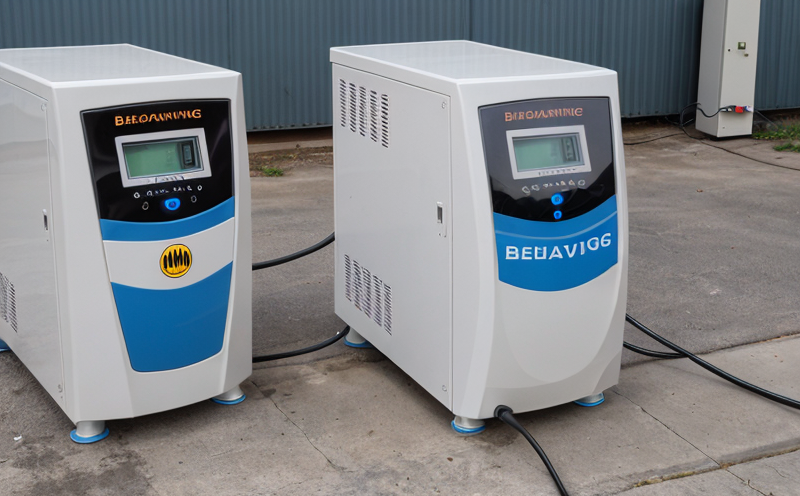IEC 62619 Charging and Discharging Behavior Testing of Industrial Lithium Batteries
The IEC (International Electrotechnical Commission) standard, IEC 62619, specifies methods for the determination of charging and discharging behavior of lithium batteries used in industrial applications. This service is essential for ensuring that battery performance meets stringent safety and reliability requirements as per industry norms.
Industrial lithium batteries, often found in power tools, medical devices, and electric vehicles (EVs), are critical components in modern manufacturing processes. Understanding their charging and discharging behavior under various conditions is crucial for optimizing system design and ensuring product longevity. This testing ensures that the battery operates efficiently across a range of environments and applications.
The test protocol outlined in IEC 62619 involves subjecting batteries to controlled charge and discharge cycles while monitoring key performance indicators (KPIs) such as internal resistance, voltage, current, capacity retention, and temperature. These parameters are critical for assessing the battery’s ability to retain its charge over time and under varying operating conditions.
Charging and discharging behavior testing is particularly important in industrial settings where continuous operation without degradation is necessary. By adhering to this standard, manufacturers can ensure that their products meet the stringent requirements of regulatory bodies like the European Union (EU) and the United States (US) Department of Transportation (DOT).
The testing process involves precise measurement techniques using specialized equipment designed for high-precision measurements. The apparatus used in these tests includes programmable power supplies, data acquisition systems, and thermal monitoring devices. These tools allow for detailed analysis of how batteries perform under different conditions, from ambient to extreme temperatures.
One of the primary objectives of this testing is to identify potential weaknesses in battery design that could lead to performance degradation or safety hazards. By conducting thorough testing, manufacturers can address these issues proactively and ensure compliance with international standards such as IEC 62619, ISO 18356, and ASTM G177.
Another critical aspect of this service is the provision of detailed reports that outline the results of each test cycle. These reports serve multiple purposes: they help quality managers make informed decisions about product improvements; assist compliance officers in ensuring regulatory adherence; and provide R&D engineers with insights into potential areas for innovation. The data collected during these tests can also be used to optimize battery performance, extend lifespan, and enhance overall reliability.
The testing process typically involves several stages: pre-test preparation, test execution, and post-test analysis. During pre-test preparation, batteries are conditioned to ensure consistent baseline conditions before testing begins. This step is crucial in obtaining accurate results that reflect the true behavior of the battery under test.
| Stage | Description |
|---|---|
| Pre-Test Preparation | Battery conditioning to ensure consistent baseline conditions. |
| Test Execution | Subjecting batteries to controlled charge and discharge cycles while monitoring key performance indicators. |
| Post-Test Analysis | Analyzing the collected data to assess charging and discharging behavior. |
During test execution, batteries are subjected to a series of charge and discharge cycles under various conditions. These conditions include different temperature ranges (from -20°C to +60°C), varying current rates, and extended cycle times. The goal is to simulate real-world usage scenarios and assess the battery’s performance in each case.
The collected data is then analyzed using statistical methods to determine the battery's charging and discharging behavior under these conditions. This analysis helps identify any trends or anomalies that may indicate potential issues with the battery design or manufacturing process.
Industry Applications
This testing is widely used in various industrial sectors where lithium batteries are critical components:
- Power tools
- Medical devices
- Electric vehicles (EVs)
- Uninterruptible power supplies (UPS)
| Sector | Application |
|---|---|
| Power tools | Battery-powered drills, saws, and other equipment. |
| Medical devices | Portable defibrillators, patient monitoring systems. |
| Electric vehicles (EVs) | Tesla Model S, Nissan Leaf. |
| Uninterruptible power supplies (UPS) | Backup power systems for data centers and critical facilities. |
Quality and Reliability Assurance
The testing ensures that batteries meet the highest quality standards, providing peace of mind to manufacturers and end-users alike. By identifying potential issues early in the development process, this service helps prevent costly failures later on.
Environmental and Sustainability Contributions
Battery testing contributes to environmental sustainability by promoting the use of more efficient and environmentally friendly energy storage solutions. Ensuring that batteries meet stringent performance criteria helps reduce waste and promote recycling practices.
- Better utilization of resources
- Reduction in battery-related emissions





